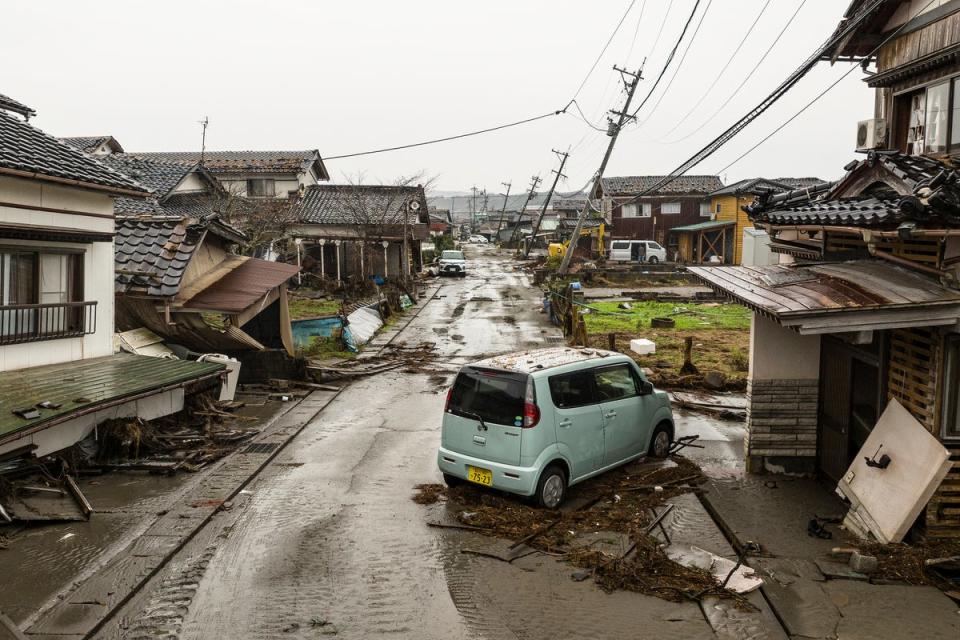Rescuers race to save those trapped by Japan earthquake with crucial 72-hour window closing
Rescue workers and canine units are racing against the clock to find people buried under the rubble by powerful earthquakes in Japan ahead of falling temperatures and heavy rain, with the crucial 72-hour window that gives the best chance of survival closing.
At least 65 people have died in the wake of Monday’s 7.6-magnitude tremor, centred on the Noto peninsula in western Japan. It has been followed by scores of aftershocks, including one measuring 4.9 on the Japanese seismic scale on Wednesday morning.
On Wednesday, nearly 130 requests for the rescue of people trapped under collapsed buildings had been recorded, according to local media, with many unreported cases also expected.
“There continue to be many reports of people who need rescue,” Japanese prime minister Fumio Kishida said on Wednesday. “We must keep in mind that this is a race against time and continue to put all our labour into rescue efforts, with lifesaving as our top priority.”
“I feel that we are at a critical moment,” he added.
The weather forecast in Ishikawa prefecture — one of the worst-hit regions in Japan — predicts heavy rain, leading to fears of landslides and further damage to the collapsed homes, impeding rescue attempts.

In Suzu, a town of about 13,000 people near the quake's epicentre, 90 per cent of houses may have been destroyed. "Hardly any of the homes are standing. They are either partially or totally destroyed," said Suzu’s mayor Masuhiro Izumiya.
Yasuhiro Kano, a resident of Suzu’s Horyu district, evacuated his mother just as his house was collapsing. Since New Year’s Day, he has moved to two shelters but now worries about food and rescue.
“At first I thought the shaking was the usual 4 or 5 on the Japanese seismic scale, but soon the vertical shaking came, and the house collapsed,” he told the Asahi Shimbun newspaper.
“My house has completely collapsed. I don’t know what will happen now. I don’t even know how long it will take to recover. I have nothing but anxiety,” he added.

Ishikawa prefecture has confirmed 65 deaths, up from 55 late on Tuesday, making the earthquake the deadliest in Japan since at least 2016. Some cities have reported additional deaths, putting the total number of fatalities at 73, according to a tally collated by Kyodo News. More than 300 people have been injured, at least 25 of them seriously.
According to the Japan Meteorological Agency (JMA), more than 400 aftershocks have struck the country, with officials warning these could continue for up to a week.
Satellite images showed extensive damage in coastal areas, revealing destroyed buildings and capsized boats.
Thousands lost their homes in the earthquake, with at least 33,000 staying at evacuation centres. Temperatures are expected to drop overnight for the thousands of survivors who are currently in makeshift shelters.
Shigeru Sakaguchi, mayor of Wajima, said he was grateful for the government's efforts but had received only 2,000 meals for some 10,000 evacuees so far.
"Some people are very cold because there are areas that have no access to electricity and therefore heating," he said.

Ishikawa governor, Hiroshi Hase urged those who are sheltering together to use face masks, as well as antiseptic and soap, to guard against any infectious diseases.
In some of the earthquake-hit regions, power, water and cell phone service were still down.
In hard-hit Wajima, firefighters pressed on, despite the rain and aftershocks, searching for a woman trapped in a wooden structure squashed by a seven-storey building that toppled over in the quake and landed on its side. The rescuers were removing rubble to try to reach the woman, who was not showing any vital signs, a firefighter said.

According to a report from the Japanese government last year, there has been a consistent rise in the frequency of earthquakes in the Noto peninsula region since 2018.
The 7.6-magnitude quake triggering tsunami warnings, but they were later lifted and Japan’s nuclear power plants along the Sea of Japan coastline remained largely unscathed. However, Japan Times reported, the incident could renew public concerns about the safety of nuclear power in an earthquake-prone country.
Additional reporting with agencies

 Yahoo News
Yahoo News 
